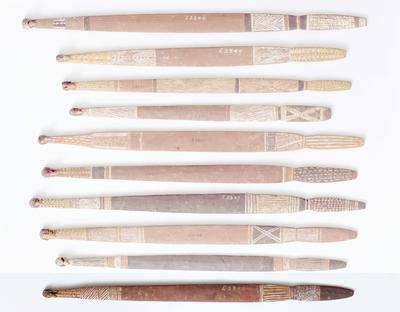Spear thrower
Production date
Pre 1940
Country
Australia
State/Province
Northern Territory
See full details
Object detail
Description
Spear thrower: linear, notched, spatulate
Description: wooden, convex similar
Distal: tapering , round pointed peg attached with gum and fibre
Proximal: tapering , rounded, notched 19 cms from end. Biased taper towards distal.
Decoration: red ochre over entire surface.
Distal: end painted in horizontal lines (yellow and white) oblique lines (yellow and white) yellow end with dots (red and black)
Proximal: black end, horizontal lines (white, yellow) vertical lines (black and white) lattice lines (white and black).
Description: wooden, convex similar
Distal: tapering , round pointed peg attached with gum and fibre
Proximal: tapering , rounded, notched 19 cms from end. Biased taper towards distal.
Decoration: red ochre over entire surface.
Distal: end painted in horizontal lines (yellow and white) oblique lines (yellow and white) yellow end with dots (red and black)
Proximal: black end, horizontal lines (white, yellow) vertical lines (black and white) lattice lines (white and black).
Maker
Production date
Pre 1940
Production place
Measurements
L929mm x D13mm x W55mm
Media/Materials description
Wood
History and use
Wamara is derived from the Dharug Aboriginal language of the Sydney region.
Woomeras (commonly called spear throwers), have a handle at one end and a peg at the other, for holding the spear. Woomeras act as an extension of the throwers arm, increasing the speed and distance the spear travels. They vary in style, depending on local traditions, wood availability and the type of spear used. In arid areas woomeras were multipurpose tools, used as a shield or dish, or fitted with a specific stone tool, called an adze, which is used in wood carving and in butchering of game. Others have distinctive carved designs.
These woomera were made at Yirrkala Mission, in the Northern Territory. These objects are part of a large collection of over 460 objects acquired via purchase from Reverend Wilbur Selwyn Chaseling in 1940. Chaseling was the first Reverend at the Yirrkala Mission, which was established in 1935. Yirrkala Mission was the last mission to be established in eastern Arnhem Land.
Woomeras (commonly called spear throwers), have a handle at one end and a peg at the other, for holding the spear. Woomeras act as an extension of the throwers arm, increasing the speed and distance the spear travels. They vary in style, depending on local traditions, wood availability and the type of spear used. In arid areas woomeras were multipurpose tools, used as a shield or dish, or fitted with a specific stone tool, called an adze, which is used in wood carving and in butchering of game. Others have distinctive carved designs.
These woomera were made at Yirrkala Mission, in the Northern Territory. These objects are part of a large collection of over 460 objects acquired via purchase from Reverend Wilbur Selwyn Chaseling in 1940. Chaseling was the first Reverend at the Yirrkala Mission, which was established in 1935. Yirrkala Mission was the last mission to be established in eastern Arnhem Land.
Registration number
E2848



